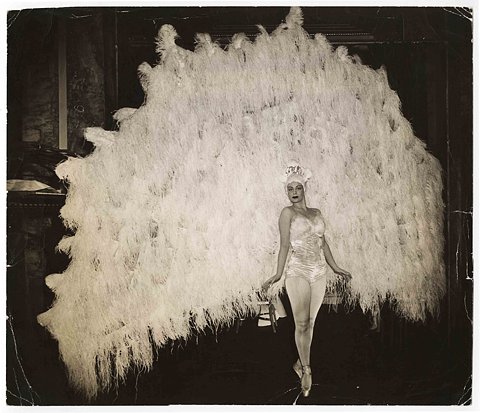A press release arrives, announcing an exhibition at the International Center of Photography in New York. Titled Unknown Weegee, the show runs from June 9 through August 27, 2006. It’s culled from ICP’s vast collection of images–over 18 thousand–made chiefly in the 1930s and ’40s by the tabloid photographer Arthur Fellig (1899-1968), best known by his moniker, Weegee. The announcement is illustrated with the strange and striking shot you see here. In this early release, the figure is not identified; the photograph is enigmatically captioned Cinderella Ball, 1941.
Weegee
Ballerina Marina Franca in her peacock costume, April 18, 1941
Gelatin silver print
© Weegee / International Center of Photography
When we look at this image today, we see double: The woman is both a symbol of classical dancing, old style–Odette with her ruff of feathers at the hip–and the iconic Vegas showgirl we can conjure up in our mind’s eye, though we’ve never been to Vegas.
Typically, Weegee captures his subject mercilessly in garish light. A crime photojournalist by trade and temperament, he pretends to do no more than document brute surface reality–the bleeding corpse lying in the gutter, with the cops forming an ironic honor guard around it. In this and his other modes, such as his portrayals of working class folks, down and outs, or victims of disaster and their avid oglers, he cannily provokes our imagination to create the story behind the image. He makes us see.
He also makes us think. Contemplating this lady in her outlandish white costume–all shimmer and froth–we wonder: Who is she? How did she arrive at this time and place? This peculiar destiny? What does her “performance” consist of? Is she, perhaps, a reluctant collaborator in her work? He also makes us dream.




